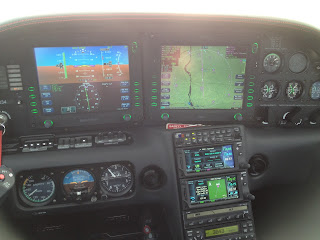Had the great privilege of helping out a fellow Cirrus owner by picking up and flying his aircraft home after getting some work done. The plane N60034, a 2003 Cirrus SR22 G1 was just completely pimped out to look better than a new Cirrus. The owner had the plane painted, interior completely redone and had a new four-blade MT propeller installed.
Midwest Aircraft Refinishing strip and repaint the entire aircraft. The quality of the paint job is like nothing I have ever seen before. It has numerous fades and color variations and all the colors have a little metal fleck in them, which really looks sharp. All stripping and numbers are painted (no cheap vinyl here) and then a final clear coat is applied to make the entire plane look wet. TRULY AMAZING! It’s not to say it’s perfect, but the flaws are few are unnoticeable unless you really look for them. Regardless, this paint job is better than any new Cirrus I have ever seen and better than any aircraft paint job I have ever seen! I would love to do this to my Cirrus!
SCS Custom Interiors in Duluth (the same manufacturer that does the factory Cirrus interior) replaced all the seat covers and foam as well as added new leather armrests and leather wrapped yokes and renovated the old plastic to look new and colored it black. The seat covers were custom designed to the owners specifications and were reshaped to look like the new G3 version and had suede inserts added to the design. The plane also received a new suede headliner and a Cirrus G3 bolster and center console panel was installed.
Finally Midwest Aircraft Refinishing also installed a new MT four-blade composite propellor to round out the package. This was a great add-on not only for looking amazing, but for also being 27 pounds lighter, it helps increase the useful load of the aircraft. This propeller also makes the plane a little quieter and takes out some of the vibration. Performance wise, the plane seemed to climb a bit better and also aided in slowing the plane down a bit if you chopped the throttle. Not really beta, but kind of like that when at speed.
Prior to having all this work done, the owner also upgraded all the G430 com/navs with the new Garmin GTN650s and is looking at getting a DFC90 installed next month. With all the work he has done to this aircraft, you have to wonder why anyone would want to buy a new aircraft. This aircraft looks, smells and performs just as good as a new 2012 Cirrus and is every bit as capable, yet total cost is a quarter of a new one! I had a great time picking it up and flying it home from Wisconsin and I’m guessing this will be the closest I will ever come to actually flying a “new” aircraft. Thanks for the opportunity Justin!




























+RW18+KDHN.PNG)

